child seat FIAT DOBLO PANORAMA 2016 2.G Owners Manual
[x] Cancel search | Manufacturer: FIAT, Model Year: 2016, Model line: DOBLO PANORAMA, Model: FIAT DOBLO PANORAMA 2016 2.GPages: 323, PDF Size: 25.46 MB
Page 24 of 323
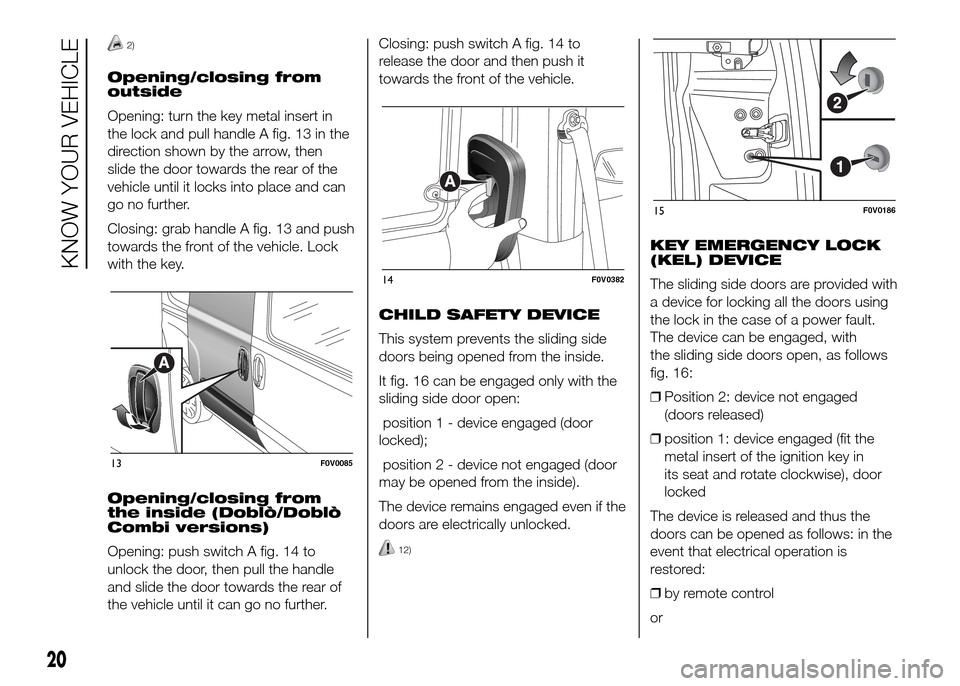
2)
Opening/closing from
outside
Opening: turn the key metal insert in
the lock and pull handle A fig. 13 in the
direction shown by the arrow, then
slide the door towards the rear of the
vehicle until it locks into place and can
go no further.
Closing: grab handle A fig. 13 and push
towards the front of the vehicle. Lock
with the key.
Opening/closing from
the inside (Doblò/Doblò
Combi versions)
Opening: push switch A fig. 14 to
unlock the door, then pull the handle
and slide the door towards the rear of
the vehicle until it can go no further.Closing: push switch A fig. 14 to
release the door and then push it
towards the front of the vehicle.
CHILD SAFETY DEVICE
This system prevents the sliding side
doors being opened from the inside.
It fig. 16 can be engaged only with the
sliding side door open:
position 1 - device engaged (door
locked);
position 2 - device not engaged (door
may be opened from the inside).
The device remains engaged even if the
doors are electrically unlocked.
12)
KEY EMERGENCY LOCK
(KEL) DEVICE
The sliding side doors are provided with
a device for locking all the doors using
the lock in the case of a power fault.
The device can be engaged, with
the sliding side doors open, as follows
fig. 16:
❒Position 2: device not engaged
(doors released)
❒position 1: device engaged (fit the
metal insert of the ignition key in
its seat and rotate clockwise), door
locked
The device is released and thus the
doors can be opened as follows: in the
event that electrical operation is
restored:
❒by remote control
or
13F0V0085
14F0V0382
15F0V0186
20
KNOW YOUR VEHICLE
Page 27 of 323
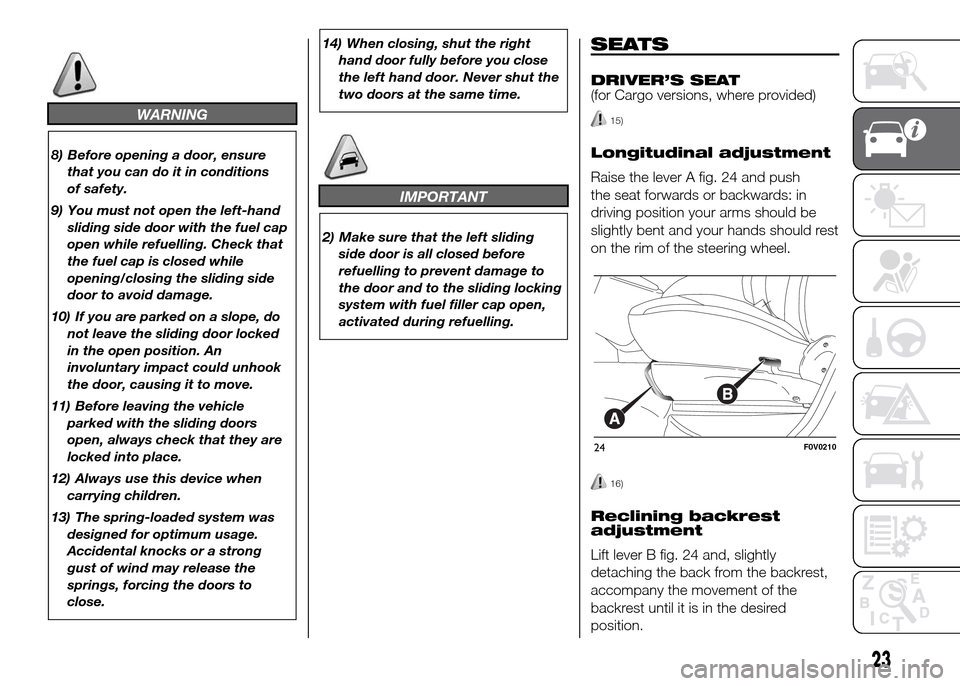
WARNING
8) Before opening a door, ensure
that you can do it in conditions
of safety.
9) You must not open the left-hand
sliding side door with the fuel cap
open while refuelling. Check that
the fuel cap is closed while
opening/closing the sliding side
door to avoid damage.
10) If you are parked on a slope, do
not leave the sliding door locked
in the open position. An
involuntary impact could unhook
the door, causing it to move.
11) Before leaving the vehicle
parked with the sliding doors
open, always check that they are
locked into place.
12) Always use this device when
carrying children.
13) The spring-loaded system was
designed for optimum usage.
Accidental knocks or a strong
gust of wind may release the
springs, forcing the doors to
close.14) When closing, shut the right
hand door fully before you close
the left hand door. Never shut the
two doors at the same time.
IMPORTANT
2) Make sure that the left sliding
side door is all closed before
refuelling to prevent damage to
the door and to the sliding locking
system with fuel filler cap open,
activated during refuelling.
SEATS
DRIVER’S SEAT
(for Cargo versions, where provided)
15)
Longitudinal adjustment
Raise the lever A fig. 24 and push
the seat forwards or backwards: in
driving position your arms should be
slightly bent and your hands should rest
on the rim of the steering wheel.
16)
Reclining backrest
adjustment
Lift lever B fig. 24 and, slightly
detaching the back from the backrest,
accompany the movement of the
backrest until it is in the desired
position.
24F0V0210
23
Page 109 of 323

SAFETY
The chapter that you are about to read
is very important: it describes the
safety systems with which the car is
equipped and provides instructions on
how to use them correctly.ACTIVE SAFETY SYSTEMS ............106
ABS ................................................106
ESC (ELECTRONIC STABILITY
CONTROL) SYSTEM .......................108
OCCUPANT PROTECTION
SYSTEMS .......................................110
SEAT BELTS ...................................111
SBR SYSTEM .................................112
PRETENSIONERS...........................113
CARRYING CHILDREN SAFELY ......115
ISOFIX CHILD RESTRAINT
SYSTEM SETUP .............................119
FRONT AIRBAGS............................121
SIDE BAGS .....................................126
105
Page 114 of 323
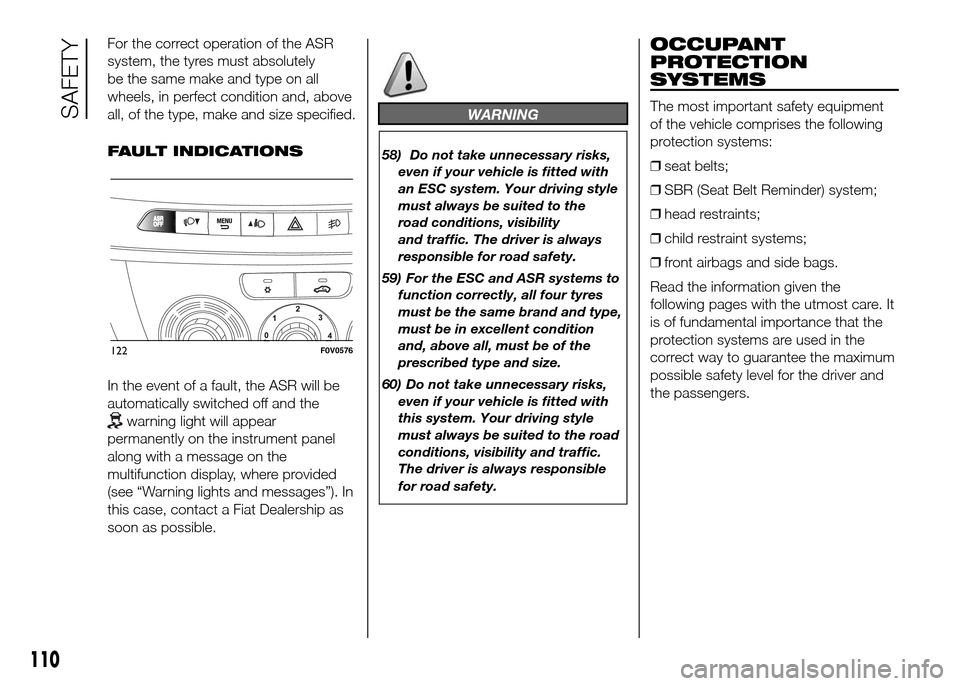
For the correct operation of the ASR
system, the tyres must absolutely
be the same make and type on all
wheels, in perfect condition and, above
all, of the type, make and size specified.
FAULT INDICATIONS
In the event of a fault, the ASR will be
automatically switched off and the
warning light will appear
permanently on the instrument panel
along with a message on the
multifunction display, where provided
(see “Warning lights and messages”). In
this case, contact a Fiat Dealership as
soon as possible.
WARNING
58) Do not take unnecessary risks,
even if your vehicle is fitted with
an ESC system. Your driving style
must always be suited to the
road conditions, visibility
and traffic. The driver is always
responsible for road safety.
59) For the ESC and ASR systems to
function correctly, all four tyres
must be the same brand and type,
must be in excellent condition
and, above all, must be of the
prescribed type and size.
60) Do not take unnecessary risks,
even if your vehicle is fitted with
this system. Your driving style
must always be suited to the road
conditions, visibility and traffic.
The driver is always responsible
for road safety.
OCCUPANT
PROTECTION
SYSTEMS
The most important safety equipment
of the vehicle comprises the following
protection systems:
❒seat belts;
❒SBR (Seat Belt Reminder) system;
❒head restraints;
❒child restraint systems;
❒front airbags and side bags.
Read the information given the
following pages with the utmost care. It
is of fundamental importance that the
protection systems are used in the
correct way to guarantee the maximum
possible safety level for the driver and
the passengers.
122F0V0576
110
SAFETY
Page 117 of 323

PRETENSIONERS
To increase the protective efficiency of
the front seat belts, the vehicle is fitted
with pretensioners. These devices, in
the event of a violent head-on crash or
side impact, rewind the seat belts a
few centimetres. In this way, they
ensure that the belts fit tightly to the
wearer before the restraining action
begins.
The seat belt retractor locks to indicate
that the pretensioner has cut in; the
seat belt cannot be drawn back up
even when guided manually.
IMPORTANT To obtain the highest
degree of protection from the action of
the pretensioner, wear the seat belt
keeping it tight to the chest and pelvis.
A slight discharge of smoke may be
produced during the activation of the
pretensioner which is not harmful and
does not indicate any fire hazard.
The pretensioner does not require any
maintenance or lubrication. Anything
that modifies its original conditions
invalidates its efficiency. If, due to
unusual natural events (floods, sea
storms, etc.), the device has been
affected by water and mud, it must
absolutely be replaced.
66)
16)
LOAD LIMITERS
(for versions/markets, where provided)
To increase passenger safety, the
front and rear seat belt retractors (for
versions/markets where provided)
contain a load limiter which controls the
force acting on the chest and
shoulders during the belt restraining
action in the event of a frontal collision.
GENERAL WARNINGS
FOR USING THE SEAT
BELTS
The driver is responsible for respecting
(and ensuring that all the other
passengers also respect) the local laws
in force regarding the use of seat belts.
Always fasten the seat belts before
setting off.
Seat belts must also be worn by
pregnant mothers: the risk of injury in
the event of an accident is greatly
reduced for them and the unborn child
if they are wearing a seat belt. Pregnant
women must position the lower part
of the belt very low down so that it
passes over the pelvis and under the
abdomen (see fig. 127 ).IMPORTANT The belt must not be
twisted. The upper part must pass over
the shoulder and cross the chest
diagonally. The lower part must adhere
to the pelvis (as shown in fig. 128)
rather than the abdomen of the
passenger. Never use devices (clips,
clamps, etc.) that hold the seat belt
away from your body.
67)
127F0V0106
128F0V0107
113
Page 118 of 323
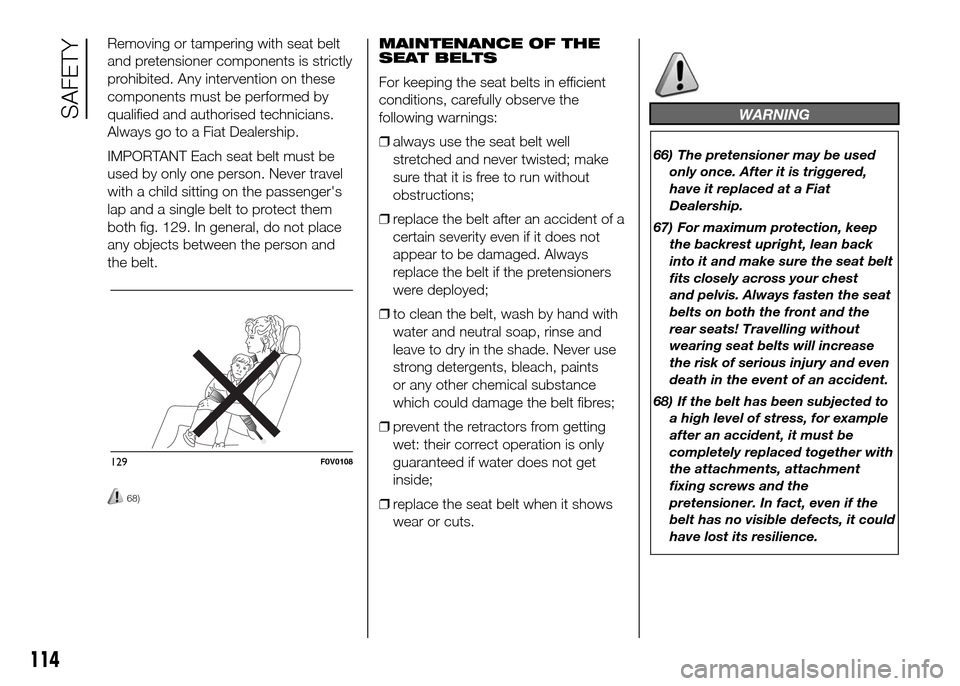
Removing or tampering with seat belt
and pretensioner components is strictly
prohibited. Any intervention on these
components must be performed by
qualified and authorised technicians.
Always go to a Fiat Dealership.
IMPORTANT Each seat belt must be
used by only one person. Never travel
with a child sitting on the passenger's
lap and a single belt to protect them
both fig. 129. In general, do not place
any objects between the person and
the belt.
68)
MAINTENANCE OF THE
SEAT BELTS
For keeping the seat belts in efficient
conditions, carefully observe the
following warnings:
❒always use the seat belt well
stretched and never twisted; make
sure that it is free to run without
obstructions;
❒replace the belt after an accident of a
certain severity even if it does not
appear to be damaged. Always
replace the belt if the pretensioners
were deployed;
❒to clean the belt, wash by hand with
water and neutral soap, rinse and
leave to dry in the shade. Never use
strong detergents, bleach, paints
or any other chemical substance
which could damage the belt fibres;
❒prevent the retractors from getting
wet: their correct operation is only
guaranteed if water does not get
inside;
❒replace the seat belt when it shows
wear or cuts.
WARNING
66) The pretensioner may be used
only once. After it is triggered,
have it replaced at a Fiat
Dealership.
67) For maximum protection, keep
the backrest upright, lean back
into it and make sure the seat belt
fits closely across your chest
and pelvis. Always fasten the seat
belts on both the front and the
rear seats! Travelling without
wearing seat belts will increase
the risk of serious injury and even
death in the event of an accident.
68) If the belt has been subjected to
a high level of stress, for example
after an accident, it must be
completely replaced together with
the attachments, attachment
fixing screws and the
pretensioner. In fact, even if the
belt has no visible defects, it could
have lost its resilience.
129F0V0108
114
SAFETY
Page 119 of 323
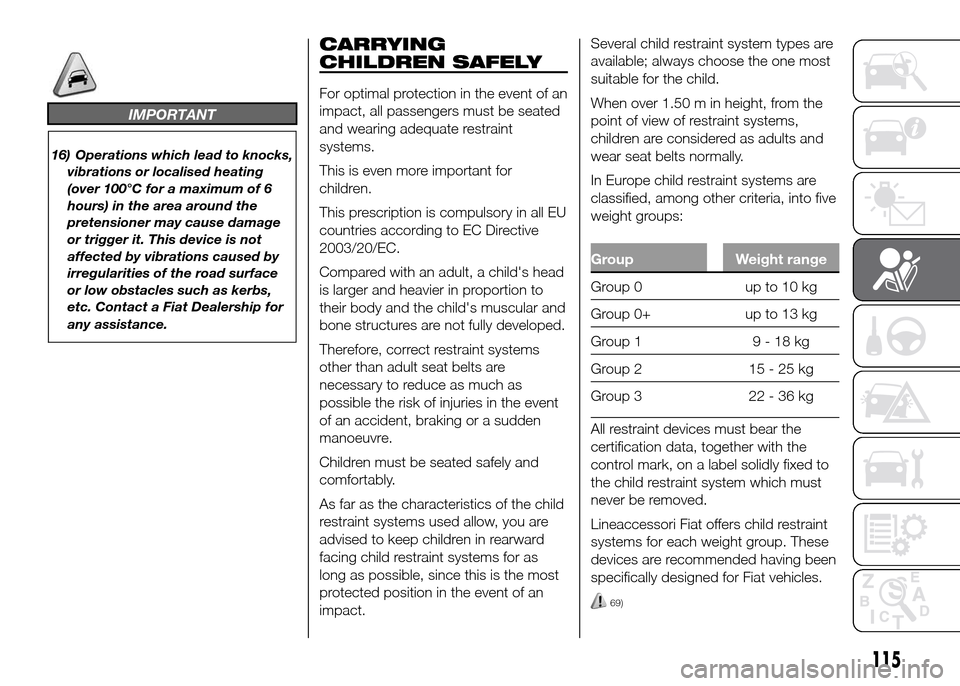
IMPORTANT
16) Operations which lead to knocks,
vibrations or localised heating
(over 100°C for a maximum of 6
hours) in the area around the
pretensioner may cause damage
or trigger it. This device is not
affected by vibrations caused by
irregularities of the road surface
or low obstacles such as kerbs,
etc. Contact a Fiat Dealership for
any assistance.
CARRYING
CHILDREN SAFELY
For optimal protection in the event of an
impact, all passengers must be seated
and wearing adequate restraint
systems.
This is even more important for
children.
This prescription is compulsory in all EU
countries according to EC Directive
2003/20/EC.
Compared with an adult, a child's head
is larger and heavier in proportion to
their body and the child's muscular and
bone structures are not fully developed.
Therefore, correct restraint systems
other than adult seat belts are
necessary to reduce as much as
possible the risk of injuries in the event
of an accident, braking or a sudden
manoeuvre.
Children must be seated safely and
comfortably.
As far as the characteristics of the child
restraint systems used allow, you are
advised to keep children in rearward
facing child restraint systems for as
long as possible, since this is the most
protected position in the event of an
impact.Several child restraint system types are
available; always choose the one most
suitable for the child.
When over 1.50 m in height, from the
point of view of restraint systems,
children are considered as adults and
wear seat belts normally.
In Europe child restraint systems are
classified, among other criteria, into five
weight groups:
Group Weight range
Group0 upto10kg
Group 0+ up to 13 kg
Group 1 9 - 18 kg
Group 2 15 - 25 kg
Group 3 22 - 36 kg
All restraint devices must bear the
certification data, together with the
control mark, on a label solidly fixed to
the child restraint system which must
never be removed.
Lineaccessori Fiat offers child restraint
systems for each weight group. These
devices are recommended having been
specifically designed for Fiat vehicles.
69)
115
Page 120 of 323

GROUP 0 and 0+
Babies up to 13 kg must be carried
rearward facing on a cradle restraint
system, which, supporting the head,
does not induce stress on the neck
in the event of sharp decelerations.
The cradle is restrained by the vehicle's
seat belts, as shown in fig. 130 and it
must restrain the child in turn with
its own belts.
GROUP 1
From 9 to 18 kg of weight, children may
be carried forward facing fig. 131.
70) 71)
GROUP 2
Children from 15 to 25 kg may use the
vehicle's seat belts directly fig. 132. The
child restraint system is needed only
to position the child correctly with
respect to the belts so that the diagonal
section crosses the child's chest and
never the neck, and the lower part
is snug on the pelvis not the abdomen.
70)
GROUP 3
For children between 22 kg and 36 kg,
there are boosters which allow the
seat belt to be worn correctly.
The fig. 133 shows the correct child
positioning on the rear seat. Children
over 1.50 m in height can wear seat
belts like adults.
130F0V0109
131F0V0196
132F0V0111
133F0V0112
116
SAFETY
Page 121 of 323
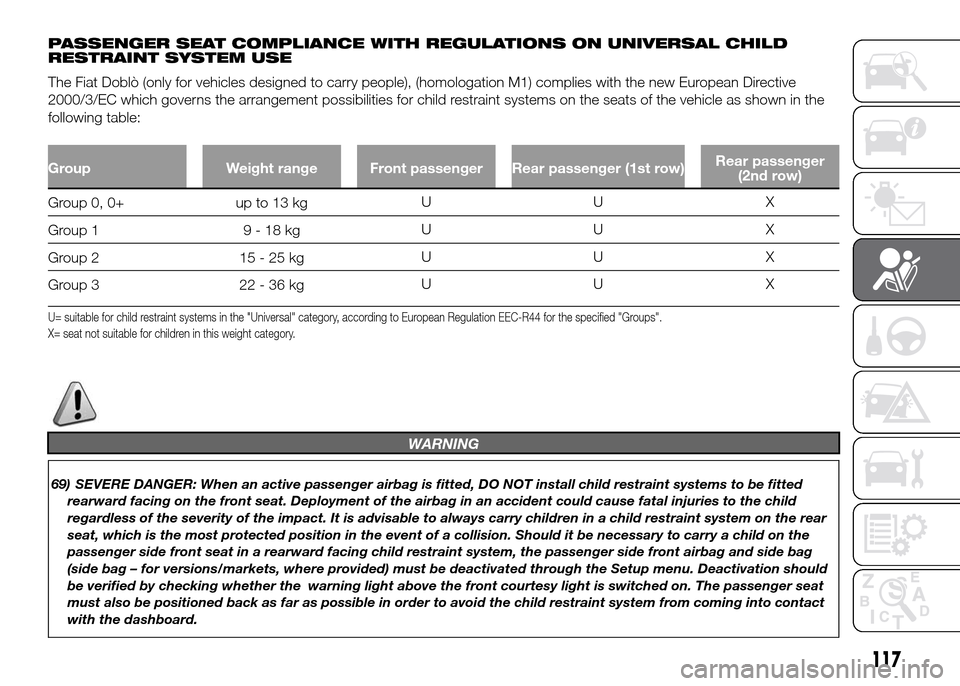
PASSENGER SEAT COMPLIANCE WITH REGULATIONS ON UNIVERSAL CHILD
RESTRAINT SYSTEM USE
The Fiat Doblò (only for vehicles designed to carry people), (homologation M1) complies with the new European Directive
2000/3/EC which governs the arrangement possibilities for child restraint systems on the seats of the vehicle as shown in the
following table:
Group Weight range Front passenger Rear passenger (1st row)Rear passenger
(2nd row)
Group 0, 0+ up to 13 kgUU X
Group 1 9 - 18 kgUU X
Group 2 15 - 25 kgUU X
Group 3 22 - 36 kgUU X
U= suitable for child restraint systems in the "Universal" category, according to European Regulation EEC-R44 for the specified "Groups".
X= seat not suitable for children in this weight category.
WARNING
69) SEVERE DANGER: When an active passenger airbag is fitted, DO NOT install child restraint systems to be fitted
rearward facing on the front seat. Deployment of the airbag in an accident could cause fatal injuries to the child
regardless of the severity of the impact. It is advisable to always carry children in a child restraint system on the rear
seat, which is the most protected position in the event of a collision. Should it be necessary to carry a child on the
passenger side front seat in a rearward facing child restraint system, the passenger side front airbag and side bag
(side bag – for versions/markets, where provided) must be deactivated through the Setup menu. Deactivation should
be verified by checking whether the warning light above the front courtesy light is switched on. The passenger seat
must also be positioned back as far as possible in order to avoid the child restraint system from coming into contact
with the dashboard.
117
Page 122 of 323
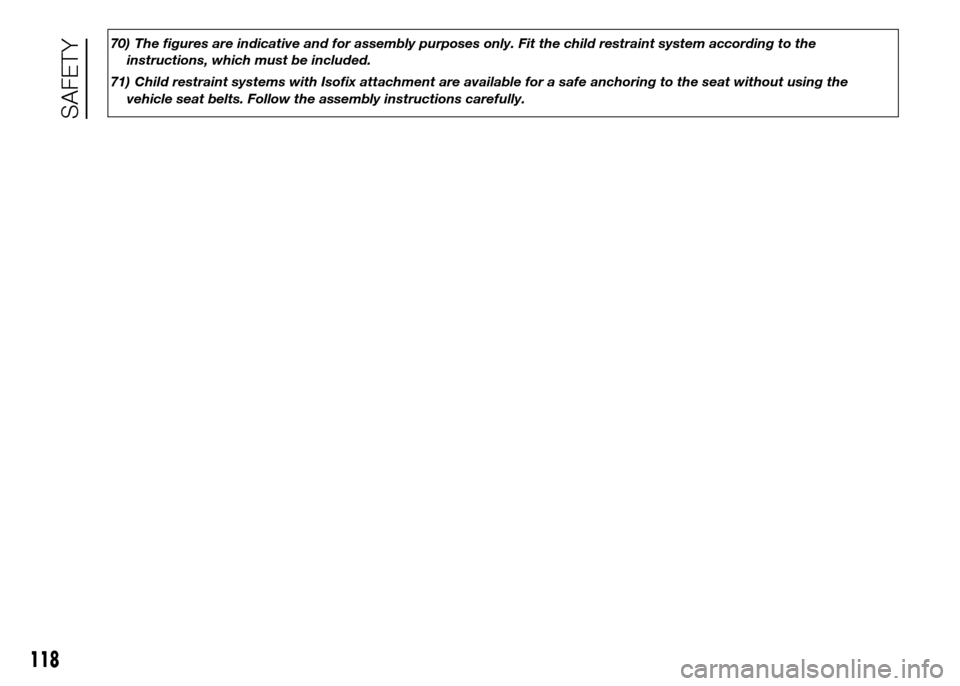
70) The figures are indicative and for assembly purposes only. Fit the child restraint system according to the
instructions, which must be included.
71) Child restraint systems with Isofix attachment are available for a safe anchoring to the seat without using the
vehicle seat belts. Follow the assembly instructions carefully.
118
SAFETY